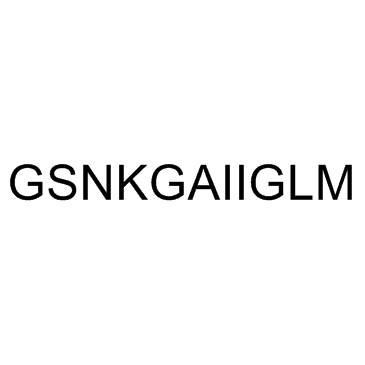β-淀粉状蛋白25-35

β-淀粉状蛋白25-35结构式

|
常用名 | β-淀粉状蛋白25-35 | 英文名 | Amyloid β-Protein (25-35) trifluoroacetate salt |
|---|---|---|---|---|
| CAS号 | 131602-53-4 | 分子量 | 1060.27000 | |
| 密度 | 1.249g/cm3 | 沸点 | 1517.336ºC at 760 mmHg | |
| 分子式 | C45H81N13O14S | 熔点 | N/A | |
| MSDS | 中文版 美版 | 闪点 | 871.453ºC |
β-淀粉状蛋白25-35用途Amyloid beta-peptide(25-35) 是阿尔茨海默氏淀粉样蛋白β肽的Aβ(25-35) 片段,在培养细胞中显示出神经毒性活性。 |
| 中文名 | BETA-淀粉样蛋白片断25-35 |
|---|---|
| 英文名 | Amyloid β-Protein Fragment 25-35 |
| 中文别名 | β-淀粉状蛋白25-35 |
| 英文别名 | 更多 |
| 描述 | Amyloid beta-peptide(25-35) 是阿尔茨海默氏淀粉样蛋白β肽的Aβ(25-35) 片段,在培养细胞中显示出神经毒性活性。 |
|---|---|
| 相关类别 | |
| 体外研究 | Aβ(25-35)肽的氨基酸序列是NH2-Gly-Ser-Asn-Lys-Gly-Ala-Ile-Ile-Gly-Leu-Met-COOH,其中第一个Gly代表氨基酸25和最后Met代表氨基酸35.淀粉样蛋白β-肽(25-35)也是首次以凝胶状态进行研究。还使用振动吸收和ECD进行比较研究。还使用振动吸收和VCD光谱研究了Aβ(25-35)肽膜的构象偏好[1]。淀粉样蛋白β肽(25-35)诱导对分离的脑线粒体的凋亡作用和甲硫氨酸-35的氧化还原状态,在诱导程序性细胞死亡途径和毒性事件中起关键作用[2]。 |
| 体内研究 | 大脑脑室内注射Aβ25-35肽,随后每天一次给予化合物丹参(CDS),持续23天。使用Morris水迷宫和被动回避监测大鼠的行为。实时PCR和Western blotting用于测定海马中淀粉样蛋白前体蛋白(APP),β位点APP裂解酶-1(BACE1),早老素-1(PS1),胰岛素降解酶(IDE)和脑啡肽酶(NEP) 。阿尔茨海默病(AD)模型组存在空间学习和记忆障碍。与AD模型组相比,CDS和多奈哌齐给药显着改善了Morris水迷宫中的Aβ25-35肽诱导的记忆障碍(P <0.05)和被动回避任务(P <0.01)[3]。 |
| 细胞实验 | 细胞活力通过改良的MTS测定法测定,该测定法基于线粒体脱氢酶将四唑鎓盐转化为在490nm处可用分光光度法测量的甲product产物。将PC12细胞以10000个细胞/孔的密度接种在96孔板中,并在完全培养基中保持16小时。然后在不存在(对照)的情况下孵育细胞,并且存在40μMAβ(31-35)和Aβ(25-35),其中使用还原的,氧化的和正亮氨酸取代的甲硫氨酸-35星形孢菌素10μM作为100%的阳性对照。细胞死亡。在肽孵育48小时后,向每个孔中加入20μLMTS试剂(2.0mg / mL)。然后将细胞在37℃,5%CO 2培养箱中孵育30-45分钟。加入25μL10%SDS终止反应。用酶标仪在490nm处读板。每个数据点使用三联孔试验获得[2]。 |
| 动物实验 | 大鼠[3]使用54只雄性Sprague-Dawley大鼠(2个月大,300-350g)。将淀粉状蛋白β-肽(25-35)溶解在无菌蒸馏水中,浓度为1mg / mL,作为放养溶液。动物注入5μL/侧无菌蒸馏水(对照),聚集Aβ25-35(2μg/μL),以1μL/ min的速率注入双侧脑侧脑室;将针留在原位5分钟。然后取出针头,将大鼠放在温暖的垫子上直到它们被唤醒。为了确定对AD大鼠的神经保护作用,用不同剂量的CDS和多奈哌齐每天一次处理Aβ25-35处理的大鼠,持续23天(包括行为测试的持续时间)。使用Morris水迷宫和逐步被动回避任务,进行实验以测试CDS对Aβ25-35诱导的记忆障碍的影响。具体地,将所有大鼠随机分成6组用于实验:(a)载体1(用于Aβ25-35)+载体2(用于CDS和多奈哌齐),(b)Aβ25-35+载体2,(c) Aβ25-35+ CDS(130 mg / kg),(d)Aβ25-35+ CDS(260 mg / kg),(e)Aβ25-35+ CDS(520 mg / kg),(f)Aβ25-35+多奈哌齐(0.5毫克/千克)。在Aβ25-35(10μg/侧)或其载体的脑室微量输注后一天,在Morris水迷宫开始之前每天一次处理大鼠(CD)或多奈哌齐或载体2(ig),持续14天,然后是被动回避任务。 |
| 参考文献 |
| 密度 | 1.249g/cm3 |
|---|---|
| 沸点 | 1517.336ºC at 760 mmHg |
| 分子式 | C45H81N13O14S |
| 分子量 | 1060.27000 |
| 闪点 | 871.453ºC |
| 精确质量 | 1059.57000 |
| PSA | 468.96000 |
| LogP | 1.05840 |
| 外观性状 | 固体 |
| 蒸汽压 | 0mmHg at 25°C |
| 折射率 | 1.544 |
| 储存条件 | -20°C |
| 个人防护装备 | Eyeshields;Gloves;type N95 (US);type P1 (EN143) respirator filter |
|---|---|
| 危险品运输编码 | NONH for all modes of transport |
| WGK德国 | 3 |
|
Neurotrophic and neurotoxic effects of amyloid beta protein: reversal by tachykinin neuropeptides.
Science 250 , 279, (1990) The amyloid beta protein is deposited in the brains of patients with Alzheimer's disease but its pathogenic role is unknown. In culture, the amyloid beta protein was neurotrophic to undifferentiated h... |
|
|
Methyllycaconitine alleviates amyloid-β peptides-induced cytotoxicity in SH-SY5Y cells.
PLoS ONE 9(10) , e111536, (2014) Alzheimer's disease (AD) is a chronic progressive neurodegenerative disorder. As the most common form of dementia, it affects more than 35 million people worldwide and is increasing. Excessive extrace... |
|
|
Mesenchymal stem cells can prevent alterations in behavior and neurogenesis induced by Aß25-35 administration.
J. Mol. Neurosci. 55(4) , 1006-13, (2015) Mesenchymal stem cells (MSCs) are known to enhance neurogenesis in the dentate gyrus, as well as to modulate immune cell activity and inflammation. Easily obtained and expanded from the bone marrow an... |
| Amyloid β-peptide (25-35) (human) |
| Amyloid beta-peptide(25-35) |


